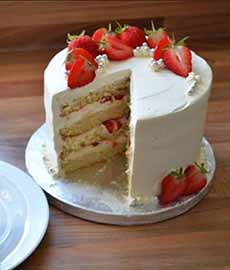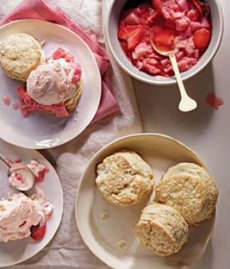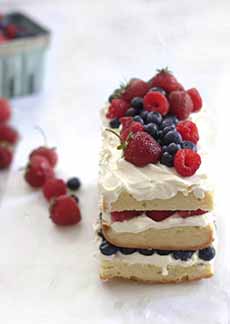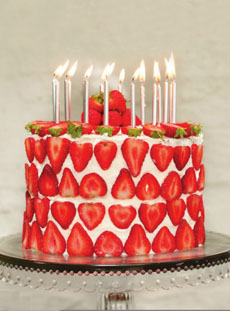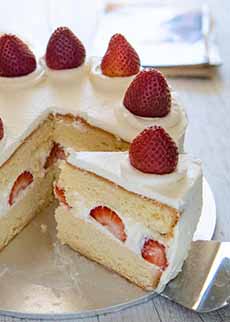Easy Shortcake Recipe, With Any Fruit You Like
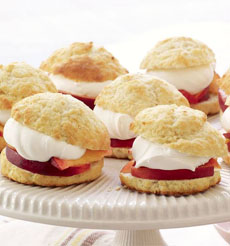 [1] Easy peach shortcake: Slice the fruit, top a biscuit half with it and add whipped cream (photo © Kraft).
|
Sweet summer berries and stone fruits beg to be turned into shortcake. It requires only three ingredients: the fruit of choice, whipped cream and the biscuit or cake base. The original shortcake concept, from the U.K., uses a slightly sweetened baking soda or baking powder biscuit or scone: a crumbly bread that has been leavened with baking powder or baking soda. Split in half, the base is piled with fruit and whipped cream, then topped with the other half, often with more fruit and whipped cream on top. Just to confirm: The classic shortcake isn’t cake, in the American sense. To us, it’s a dry biscuit: a crumbly, roll-shaped bread that has been leavened with baking powder or baking soda. As time marched forward, the classic biscuit base remained, but new variations evolved. The history of shortcake continues below. June 14th is National Strawberry Shortcake Day. If you don’t have to bake the biscuits, this is a pretty easy recipe to assemble. There’s a shortcake biscuit recipe below, but other choices include: |
|
|
|
||
|
RECIPE #2: SHORTCAKE BISCUITS Shortcake biscuits add a bit of sugar to a conventional biscuit recipe. Ingredients 1. PREHEAT the oven to 450°F. Grease a cookie sheet. 2. SIFT the dry ingredients together. Beat 2 eggs with milk and set aside. 3. MIX 3/4 cup shortening with the dry ingredients. Add the milk and eggs and knead on a board for a few minutes. 4. ROLL the dough out 3/4 inch thick. Cut with a round cookie cutter and bake 10 to 15 minutes on greased cookie sheet. Cool on a rack. 5. ASSEMBLE: Cut biscuits in half. Spoon some of the fruit and any juice onto each shortcake bottom. Top with whipped cream and add the shortcake top (you can serve the shortcake open face if you prefer). Spoon more fruit over the top and serve. The first known strawberry shortcake recipe appeared in an English cookbook around 1588. The original concept used a slightly sweetened baking soda or baking powder biscuit or scone [source]. The next recipe of note was published in 1847 by food writer Eliza Leslie in The Lady’s Receipt-Book. An 1850 recipe creates the dish with biscuits, butter, strawberries and sweetened cream. Perhaps a way to create a tea-time dessert from leftover breakfast biscuits, softening them with biscuits and cream? By 1850, strawberry shortcake was a well-known biscuit-and-fruit dessert, served hot with butter and sweetened cream. But by 1910 the modern version emerged, using whipped cream as the topping, as the French did with their own version, the strawberry génoise (more about that in a minute). American Shortcake The concept of using a biscuit traveled across the pond. Split in half, the base was piled with fruit and whipped cream, then topped with the other half of the biscuit, often with more fruit and whipped cream on top (photos #1 and #6). In the U.S., shortcake parties were held as celebrations of the summer fruit harvest, typically using berries and stone fruits. Some of the earliest American recipes used pie crust rounds or broken-up pieces of baked pie crust. According to Wikipedia, that recipe that can still be found in the South. However, another version of shortcake emerged, based on the French sponge cake, called génoise (zhen-WOZ). Sponge layers were filled with whipped cream and strawberries, and the cake was frosted with more whipped cream (photos #2, #5 and #7). Some housewives baked a standard sponge cake in a tube pan, sliced it horizontally and used the same filling. To make the dessert easier for housewives, some commercial bakeries created sponge dessert cups—individual sponge cake cups that only required strawberries topped with whipped cream. More recently, Japanese bakers created a hybrid of the American and the French versions. As the concept has evolved, biscuits and sponge have been replaced by everything from: How about a pot luck where everyone brings his/her own creation? Please invite us! |
|
|
|
|
||
